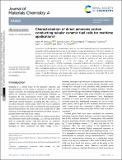Files in this item
Characterisation of direct ammonia proton conducting tubular ceramic fuel cells for maritime applications
Item metadata
| dc.contributor.author | Nowicki, Kamil M. | |
| dc.contributor.author | Carins, George | |
| dc.contributor.author | Bayne, John | |
| dc.contributor.author | Tupberg, Chayopas | |
| dc.contributor.author | Irvine, Gavin J. | |
| dc.contributor.author | Irvine, John T. S. | |
| dc.date.accessioned | 2022-12-12T17:30:04Z | |
| dc.date.available | 2022-12-12T17:30:04Z | |
| dc.date.issued | 2023-01-07 | |
| dc.identifier | 282538384 | |
| dc.identifier | a96efb66-2ef8-4315-8a46-09bf438a8167 | |
| dc.identifier | 85144653785 | |
| dc.identifier | 000895061900001 | |
| dc.identifier.citation | Nowicki , K M , Carins , G , Bayne , J , Tupberg , C , Irvine , G J & Irvine , J T S 2023 , ' Characterisation of direct ammonia proton conducting tubular ceramic fuel cells for maritime applications ' , Journal of Materials Chemistry A , vol. 11 , no. 1 , pp. 352-363 . https://doi.org/10.1039/d2ta07310b | en |
| dc.identifier.issn | 2050-7488 | |
| dc.identifier.other | Jisc: 775396 | |
| dc.identifier.other | publisher-id: d2ta07310b | |
| dc.identifier.other | ORCID: /0000-0002-8394-3359/work/124889136 | |
| dc.identifier.uri | https://hdl.handle.net/10023/26582 | |
| dc.description.abstract | Ammonia is now being widely considered as a carrier for low carbon hydrogen due to its favourable physical properties and the existing infrastructure for its transport, storage and distribution. The direct utilisation of ammonia in Protonic Ceramic Fuel Cells (PCFCs) has the advantages of ammonia cracking activity and avoiding mixing of ammonia with generated steam. Here we seek to demonstrate a low-carbon electrical power generation system based on a PCFC fueled by ammonia for port and maritime applications. The performance of a 36 cm2 tubular cell with a proton conductive BaCe0.7Zr0.1Y0.16Zn0.04O3−δ (BCZYZ) electrolyte, composite Ni/BaCe0.7Zr0.1Y0.16Zn0.04O3−δ (Ni/BCZYZ) fuel electrode and La0.8Sr0.2Co0.5Fe0.5O3−δ/BaCe0.7Zr0.1Y0.16Zn0.04O3−δ LSCF/BCZYZ air electrode has been investigated using pure ammonia fuel. The tested cell generated up to 8.5 W with a maximum power density of 0.236 W cm−2 at 750 °C. The cell was operated in pure NH3, repeatedly characterised using I–V and EIS techniques, and tested under load to generate current for more than 140 h, with a fairly stable performance at a current above 8 A. | |
| dc.format.extent | 12 | |
| dc.format.extent | 1213283 | |
| dc.language.iso | eng | |
| dc.relation.ispartof | Journal of Materials Chemistry A | en |
| dc.subject | QD Chemistry | en |
| dc.subject | NDAS | en |
| dc.subject | MCC | en |
| dc.subject.lcc | QD | en |
| dc.title | Characterisation of direct ammonia proton conducting tubular ceramic fuel cells for maritime applications | en |
| dc.type | Journal article | en |
| dc.contributor.institution | University of St Andrews. School of Chemistry | en |
| dc.contributor.institution | University of St Andrews. Centre for Energy Ethics | en |
| dc.contributor.institution | University of St Andrews. Centre for Designer Quantum Materials | en |
| dc.contributor.institution | University of St Andrews. EaSTCHEM | en |
| dc.identifier.doi | 10.1039/d2ta07310b | |
| dc.description.status | Peer reviewed | en |
This item appears in the following Collection(s)
Items in the St Andrews Research Repository are protected by copyright, with all rights reserved, unless otherwise indicated.

